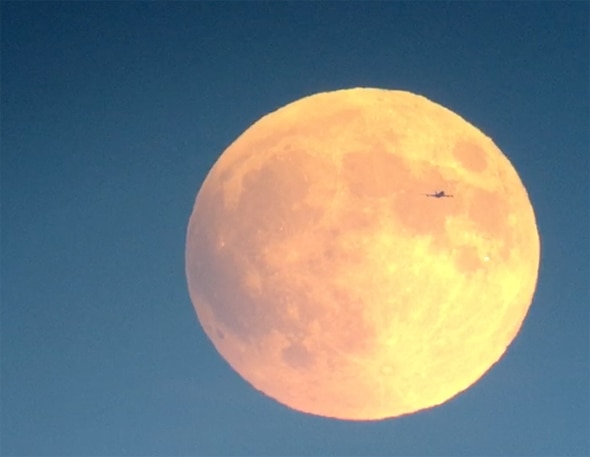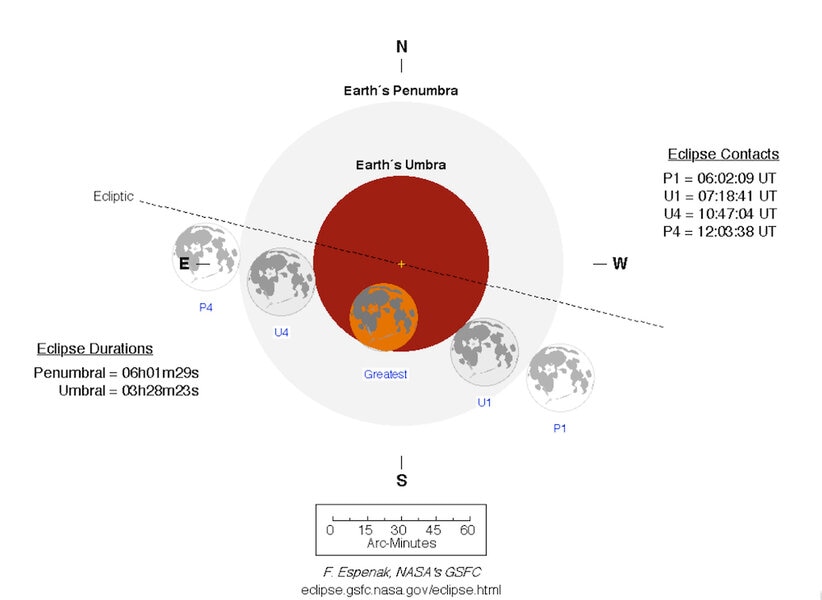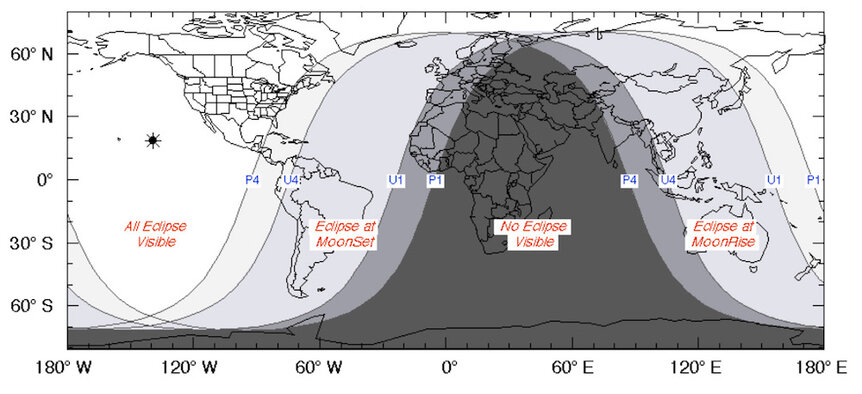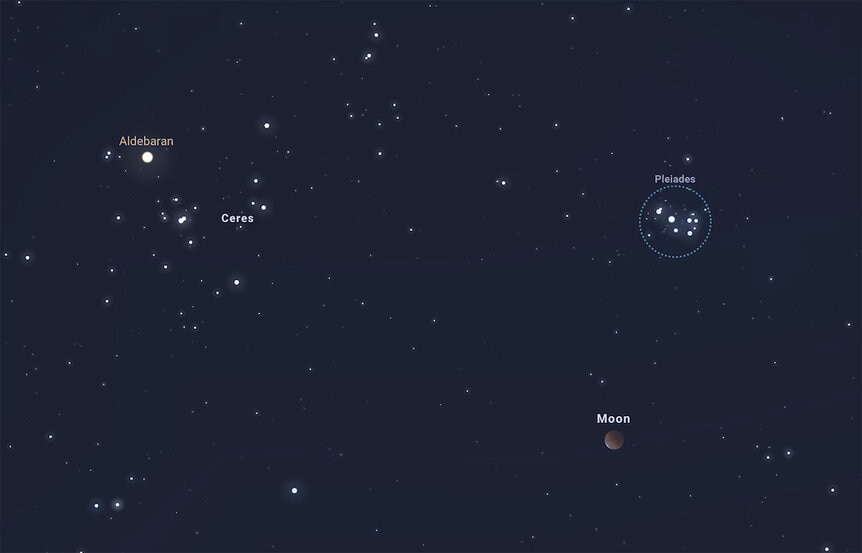Create a free profile to get unlimited access to exclusive videos, sweepstakes, and more!
Get ready for Thursday night's (almost very nearly total) lunar eclipse!
How to watch Thurday's lunar eclipse, the longest of the century.

Starting Thursday night/Friday morning, the sky will put on a show: A lunar eclipse, when the Moon passes into and out of Earth's shadow. This one strongly favors viewers in North America, but will be visible in part from Central and South America and eastern Asia.
These are always fun, but this one is unusual in a number of ways. For one, the Moon will be near apogee, the farthest point in its elliptical orbit around the Earth, so it will appear slightly smaller than average and also be moving more slowly, so the eclipse lasts a bit longer than usual. It'll actually be the longest partial lunar eclipse in the century.
But more importantly this is almost but not quite a total eclipse; very very close but not exactly. About 97% of the Moon will be in Earth's deep shadow, so even at maximum eclipse a little tiny bit near its south pole will still be lit by the Sun. That should look pretty cool, so it's worth taking a look.
I get this question a lot, so right off the bat: It's perfectly safe to observe a lunar eclipse with your naked eye, with binoculars (which I strongly recommend), or even a telescope. It's a solar eclipse that can be dangerous to view, when the Moon blocks the Sun. But a lunar eclipse is when the Earth blocks the Sun as seen from the Moon, so it's all good to watch.
A lunar eclipse happens when the Sun, Earth, and Moon align, with the Earth between the Sun and Moon. The Earth's shadow is always out there in space, but the Moon's orbit is tilted a little with respect to Earth around the Sun (about 5°) and the Moon is small (about 0.5° in our sky) so it usually misses, going "above" or "below" it. But sometimes the Moon is at the right place at the right time, and passes right through Earth's shadow.
I explain how all this works in "Crash Course Astronomy: Eclipses", so give that a watch for a general explanation of the mechanics of an eclipse and what you'll see in general.
The Earth actually casts two shadows, essentially a narrow cone nestled inside a wider one. If you project these onto the sky the outer shadow, called the penumbra, is about 4 degrees across, and the inner one, the umbra, is roughly 2° wide.
If you're on the Moon when it's in the penumbra you see the Earth partially blocking the Sun, so the shadow isn't very dark. But if you're on the part of the Moon in Earth's umbral shadow the Sun is completely blocked, so it gets dark.
The Moon enters the penumbral shadow (this moment is called P1) at 06:02 UTC Friday morning (01:02 Eastern US time; note that for Mountain and Pacific that's 23:02 and 22:02 Thursday night, respectively). You won't really notice this since that part of the shadow isn't very dark.
It starts to enter the umbral shadow (U1) at 07:18 UTC, and you'll see that as the western (on the Moon's left for northern hemisphere observers) part of the Moon starting to get dark, like a line drawn across it. Over the next few minutes as the Moon goes deeper into the umbra it will look like a bite is taken out of it, growing in size.
The eclipse maximum is at 09:02 UTC (04:02 Eastern US time)*. Everything but the very southern tip will be dark, but even that part won't be lit brightly.
Many times as the Moon slips into Earth's darkest shadow it appears brownish, then near eclipse maximum it turns a deep, blood red. In this case the southern tip may look orange or yellowish. That should be fascinating to see!
Why does it turn red? From the Moon, you see the solid Earth blocking the Sun. But the Earths atmosphere is still lit by the Sun, and can look red for the same reason sunrises and sunsets look red, and from the Moon you're essentially seeing all the sunrises and sunsets all over Earth simultaneously! So this indirect illumination can make the Moon look quite red during an eclipse, which is eerie and quite lovely.
After maximum eclipse the Moon will begin to move out of the Earth's umbral shadow (U4), leaving it entirely at 10:47 UTC. It leaves the penumbral shadow (P4) a 12:03 UTC, and at that point the eclipse is over.
It should look very similar to the April 2014 eclipse, seen in this wonderful time-lapse by my friend Adam Block:
Who gets to see it?
In that map, any area in white sees the whole thing. If you're just past the eastern edge (like, say, in Cuba or the eastern US coast) the Moon sets around sunrise, just before the eclipse totally ends. For most of South America the Moon sets still partially in the umbra. The western strip of Africa sees the Moon set while still entering the penumbra, so they won't see much. Everyone in the dark region won't see anything; their part of the Earth will be facing away from the Moon when it happens. For folks in the shaded areas in the right the Moon rises near the end of the eclipse.
As it happens, the Moon will be in the constellation of Taurus during this eclipse, and very near both the Hyades star cluster (which makes up the V-shape of the head of the bull and its horns) and even close to the lovely Pleiades cluster, which look like a mini-version of the Little Dipper. When the Moon is darker those should be obvious, so if you want to try your hand at astrophotography that would be the best time. I expect we'll see some pretty cool photos. Bonus: The protoplanet Ceres is right in the middle of the Hyades at the time, so some deep photos should pick it up. Consult a star chart to find it.
If you want more info I recommend the Sky and Telescope writeup and the one at Time and Date as well. You can always just search on it as well; tons of sites out there describe what'll happen and how to watch.
Just remember it may be cold out, and this happens overnight, so dress warmly. And since it's a slow event, unfolding over many hours, you can go outside for a few minutes every now and again to check the progress, then go back in. That's how I do it.
Good luck, and may you have clear skies and great viewing!
* CORRECTION: I orginally write that 09:02 UTC was 02:02 Eastern, but it's 04:02.





























